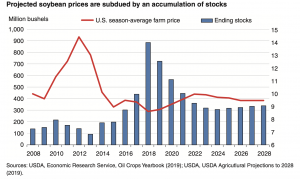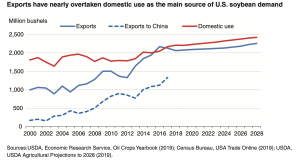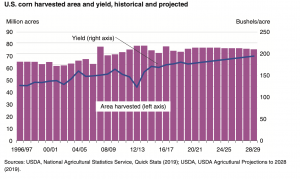Agriculture leaders in the United States House of Representatives are looking to provide at least an additional $10 billion in farmer aid to supplement the recently announced Farmer Bridge Assistance…
USDA Baseline Background, Outlook, and Recent Projections
Last week, the USDA’s Economic Research Service (ERS) released a report (“A Deeper Look Into the USDA Crop Baseline Projections to 2028, With a Focus on Trade,” by Mark Ash, Jennifer K. Bond, Thomas Capehart, Nathan W. Childs, James Hansen, Olga Liefert, Michael McConnell, Leslie Meyer, and Kim Hjort), which stated that, “This report complements the USDA Agricultural Projections to 2028 report released in March 2019 by providing an overview of the process for generating the U.S. Department of Agriculture’s long-term projections. In particular, the report explains the expectations of the main drivers of the major crop markets, including corn, soybeans, wheat, cotton, rice, and sugar. The report also focuses on demand for U.S. commodities in the international markets.”
This report examines the forces driving demand for US commodities in international markets. https://t.co/q2n1rO4xf1 pic.twitter.com/sWDHROioln
— USDA_ERS (@USDA_ERS) November 1, 2019
Meanwhile, on Friday, the USDA’s Office of the Chief Economist (OCE) released selected tables from the Department’s Agricultural Projections to 2029.
Just released: USDA's Agricultural Projections to 2029 for U.S. row crops, sugar, and livestock supply & use
— USDA Office of the Chief Economist (@usda_oce) November 1, 2019
See tables at https://t.co/Ef15fQmFy8
#agriculture #OATT pic.twitter.com/PmrDtdQTP5
Today’s update highlights aspects from both the ERS report, and the OCE projections that focused on soybeans and corn.
ERS 2028 Baseline Report- Soybeans
The ERS report explained that, “Exceptionally favorable weather over the last few years produced above-trend soybean yields.
Following a 25-percent hike in China’s import tariff on U.S. soybeans in July 2018, U.S. sales to the world’s top import market had come to a near standstill as China turned almost exclusively to Brazil as a supplier. U.S. prices dropped sharply as a consequence. The ensuing combination of a record 2018/19 harvest and reduced exports is swelling U.S. season-ending soybean stocks to an unprecedented level.
“The Market Facilitation Program (MFP) is assisting eligible soybean farmers hurt by trade disruptions through direct payments of $1.65 per bushel on a producer’s 2018 soybean production.”

The report added that, “But with the baseline assumption of continuation of the higher Chinese tariffs, soybean acreage was expected to recover slowly over the next 10 years and only gradually reduce the stock surplus. Coupled with a steady rise in the values of soybean meal and soybean oil, prices for soybeans are expected to eventually strengthen.”
With respect to demand, ERS explained that, “Over the 10-year projection period, domestic demand makes up roughly 48 percent of total soybean use. Abundant supplies will support an increase in the soybean crush, although slow growth is anticipated.”

Turning to export demand, last week’s update stated that, “While the domestic use of soybeans is expected to increase over time, exports will overshadow the contribution to the growth in total demand. Historically, U.S. soybean demand had a predominantly domestic orientation, despite the U.S. formerly being the world’s largest exporter of the crop. Over the last two decades, however, the market landscape faced by U.S. producers was permanently reshaped by the extraordinary gains in China’s soybean demand. By 2016/17, as much as 61 percent of all U.S. soybean exports were sold to China.
Indeed, for the last 3 years, nearly as many U.S. soybeans were shipped into the export market as were used domestically.
“However, the recent tariff increase by China represents a new impediment to U.S. export growth. Until those barriers to exports to China are lifted or reduced, U.S. soybean trade will be more focused on the rest of the world.”

“Maintaining the U.S. share of the global export market next year is far from assured, as foreign competition will remain formidable,” ERS said; adding that, “Each year, soybean supplies in Brazil are establishing new heights with a steady expansion of area and improving yields. For the past 7 years, Brazil has been the world’s top soybean-exporting country. Recent expansion of port capacity in Brazil is also lowering the freight cost and delivery time of export shipments.”

ERS 2028 Baseline Report- Corn
While discussing corn variables, the ERS authors pointed out that, “By the end of the projection period, yields were expected to reach 194.5 bushels per acre. Production during the baseline period trends upward as higher yields offset lower acreage for a gain of 9.5 percent over the baseline period to 16.4 billion bushels.”

More specifically on corn demand, the report noted that, “The largest growth is in feed and residual use, rising 20 percent from 2018/19 to reach 6.7 billion bushels in 2028/29. Feed and residual use tends to increase as the balance sheet gets larger due to increased statistical error, and it is also supported by 3.8 percent annual growth in per capita meat consumption during the baseline period, led by pork, beef, and poultry.”

“Ethanol peaks during the early forecast years, then declines during the last 8 years of the projection period,” the report said. “Ethanol use is a function of gasoline consumption, which declines mostly due to increased vehicle fuel efficiency, augmented by lower miles driven during some years along with a larger fleet of electric vehicles, according to projections from the Energy Information Administration. The ethanol component of gasoline is assumed to remain relatively steady at about 10 percent as alternative blends such as E-15 and E-85 are expected to contribute little to overall ethanol use.”
On the issue of corn exports, ERS stated that, “Global corn exports are dominated by four countries that produce about half of the world’s corn (the United States alone produces about 38 percent of global corn), and their combined exports are projected to reach almost 90 percent of global corn trade.
Although the United States continues to be by far the world’s top corn producer and exporter, its shares in both world output and exports are expected to decline over the next decade. During the same period, the combined corn output and exports of the three main U.S corn competitors—Brazil, Argentina, and Ukraine—are expected to grow, so that by the end of the projection period they will produce 17 percent of world output and export more than half of all corn traded worldwide.
The ERS authors also pointed out that, “Corn producers in South America (Brazil and Argentina), Ukraine, and less so in Russia have been increasingly capturing the steady growth in global corn trade, and this trend is expected to continue.”

OCE 2029 Projections
On Friday, the USDA-OCE noted that, “The USDA will release the complete USDA Agricultural Projections to 2029 report in February 2020. The complete report will include the tables below, plus a full discussion of the commodity supply and use projections and projections for farm income and global commodity trade.
“The Agricultural Act of 2018 is assumed to be extended and remain in effect through the projection period. The projections reflect a composite of model results and judgment-based analyses and were prepared during August through October 2019.
“The projections use as a starting point the short-term forecasts from the October 10, 2019 World Agricultural Supply and Demand Estimates report.”
Following are a few tweets and graphs related to the OCE update:
Similarly, soybean exports are projected to rise to 2.24 billion bushels in 2029/30 from 1.75 billion in 2018/19 as the U.S. reestablishes global market share.
— USDA Office of the Chief Economist (@usda_oce) November 4, 2019
See https://t.co/3bqOR8jcz9
^RJ, USDA Chief Economist#soybean # agriculture
USDA published key tables from its baseline projections to 2029. Here are some of the main numbers for U.S. #corn, #soybeans, and #wheat in 2020/21.
— Karen Braun (@kannbwx) November 1, 2019
The projections use the short-term forecasts from the October 2019 WASDE as a starting point. pic.twitter.com/NZk0ovJXHO
This year #NoPlant19 helped us unwind the #soybean stocks in a hurry wrt #China & #Trade...But we're still going to need some more bins #oatt pic.twitter.com/Kl8lbPqdgo
— John Newton (@New10_AgEcon) November 1, 2019





